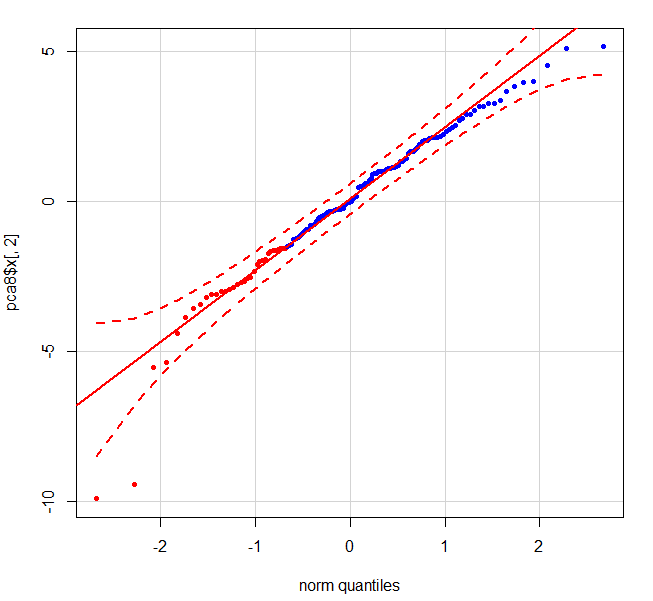I have a 132 x 107 dataset which consists of 2 patient types - (33 of patient 1) and (99 of patient 2).
I'm looking for outliers so I've run pca on the dataset and done qqplots of the 1st 4 components, using the following commands
pca = prcomp(data, scale. = TRUE)
plot(pca$x, pch = 20, col = c(rep("red", 33), rep("blue", 99)))
When I do the qqplot of the 2nd component using:
qqPlot(pca$x[,2],pch = 20, col = c(rep("red", 33), rep("blue", 99)))
the following graph shows 2 clear outliers - the red dots in the bottom left corner which are patient 1s.

Is there any straightforward way of working out the index of these points in the data so they can be removed?
For some reason, I don't believe that the identify method is supported
in the car package (the source of qqPlot())
Let's take a look at a PCA of the USArrests data...
pca <- prcomp(USArrests)
The plot of this using qqPlot is easy enough.
require(car)
qqPlot(pca$x[,2],pch = 20, col = c(rep("red", 33), rep("blue", 99)))
However, qqPlot() does not allow for point selection via identify().
identify(qqPlot(pca$x[,2],pch = 20, col = c(rep("red", 33), rep("blue", 99))))
# numeric(0)
You can, however, make use of qqnorm() in the stats package.
identify(qqnorm(pca$x[,2],pch = 20, col = c(rep("red", 33), rep("blue", 99))))
This will produce a less sophisticated graph, but you should be able to add a line and confidence intervals manually via qqline() (also in stats) and a little more math.
If you love us? You can donate to us via Paypal or buy me a coffee so we can maintain and grow! Thank you!
Donate Us With